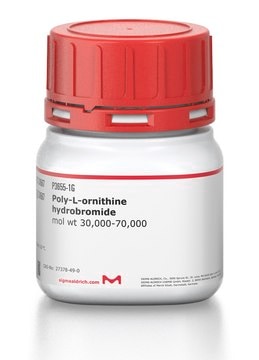P4957
Poly-ʟ-Ornithine
synthetic, mol wt 30,000-70,000, liquid, 0.01%, suitable for cell culture
About This Item
Recommended Products
product name
Poly-L-ornithine solution, mol wt 30,000-70,000, 0.01%, sterile-filtered, BioReagent, suitable for cell culture
biological source
synthetic
Quality Level
sterility
sterile-filtered
product line
BioReagent
form
solution
mol wt
30,000-70,000
packaging
pkg of 50 mL
concentration
0.01%
technique(s)
cell culture | mammalian: suitable
surface coverage
4 μg/cm2
impurities
endotoxin, tested
shipped in
ambient
storage temp.
2-8°C
SMILES string
Br.NCCCC(N)C(O)=O
InChI
1S/C5H12N2O2.BrH/c6-3-1-2-4(7)5(8)9;/h4H,1-3,6-7H2,(H,8,9);1H
InChI key
GWRQMKDBBHFVIZ-UHFFFAOYSA-N
General description
Application
Biochem/physiol Actions
Preparation Note
related product
Storage Class Code
10 - Combustible liquids
WGK
WGK 3
Flash Point(F)
Not applicable
Flash Point(C)
Not applicable
Regulatory Listings
Regulatory Listings are mainly provided for chemical products. Only limited information can be provided here for non-chemical products. No entry means none of the components are listed. It is the user’s obligation to ensure the safe and legal use of the product.
JAN Code
P4957-VAR:
P4957-BULK:
P4957-50ML:
Certificates of Analysis (COA)
Search for Certificates of Analysis (COA) by entering the products Lot/Batch Number. Lot and Batch Numbers can be found on a product’s label following the words ‘Lot’ or ‘Batch’.
Already Own This Product?
Find documentation for the products that you have recently purchased in the Document Library.
Customers Also Viewed
Articles
Poly-Lysine enhances electrostatic interaction between negatively-charged ions of the cell membrane and positively-charged surface ions of attachment factors on the culture surface. When adsorbed to the culture surface, it increases the number of positively-charged sites available for cell binding.
Frequently asked questions about neural stem cells including NSC derivation, expansion and differentiation.
Derivation and characterization of functional human neural stem cell derived oligodendrocyte progenitor cells (OPCs) that efficiently myelinate primary neurons in culture.
3D cell culture overview. Learn about 2D vs 3D cell culture, advantages of 3D cell culture, and techniques available to develop 3D cell models
Protocols
A stem cell culture protocol to generate 3D NSC models of Alzheimer’s disease using ReNcell human neural stem cell lines.
Step-by-step culture protocols for neural stem cell culture including NSC isolation, expansion, differentiation and characterization.
Our team of scientists has experience in all areas of research including Life Science, Material Science, Chemical Synthesis, Chromatography, Analytical and many others.
Contact Technical Service












